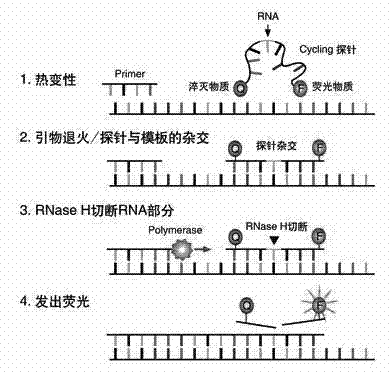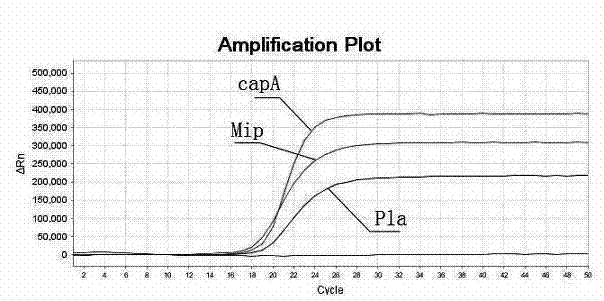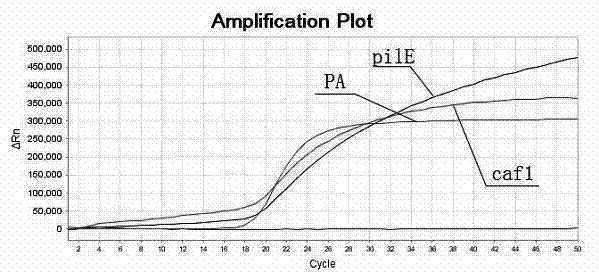Primer and probe sequences and method for detecting Bacillus anthracis, Yersinia pestis and legionella pneumophilia through multiple real-time fluorescence polymerase chain reaction (PCR)
A technology of Yersinia pestis, primer probe sequence, applied in biochemical equipment and methods, measurement/testing of microorganisms, resistance to vector-borne diseases, etc.
- Summary
- Abstract
- Description
- Claims
- Application Information
AI Technical Summary
Problems solved by technology
Method used
Image
Examples
preparation example Construction
[0089] 2. Preparation of Target Gene Plasmid Standards
[0090] Extract genomic DNA from inactivated Bacillus anthracis, Yersinia pestis and Legionella pneumophila; A pair, a set of mip primer pairs, and a set of pile primer pairs were amplified by PCR to obtain the corresponding target gene amplification products (capA gene fragment, PA gene fragment, pla gene fragment, caf1 gene fragment, Mip gene fragment , pilE gene fragments); each amplified product was recovered and purified, and respectively connected to PGEM-T easy plasmid, transformed, and extracted plasmid DNA, thereby obtaining the plasmid standard product of each target gene; determining the plasmid standard product of each target gene After the concentration is obtained, dilute and aliquot as needed, and store at -20°C for later use.
[0091] Among them, the methods for extracting genomic DNA include: DNA extraction solution extraction, PCR reaction solution lysis extraction, or DNA extraction kit extraction, all...
Embodiment 1
[0132] Example 1 Triple real-time fluorescent quantitative PCR detection of Bacillus anthracis, Yersinia pestis, and Legionella pneumophila.
[0133] (1) After inactivating Bacillus anthracis, Yersinia pestis and Legionella pneumophila respectively, they were mixed as mock positive samples. Extract the genomic DNA of the simulated positive sample to obtain the test solution.
[0134] (2) Two 25 μl triple real-time fluorescent quantitative PCR reaction systems under the same reaction conditions were used: the first reaction system was directed against the capA gene of Bacillus anthracis, the pla gene of Yersinia pestis, and the Mip gene of Legionella pneumophila; The second reaction system targets the PA gene of Bacillus anthracis, the caf1 gene of Yersinia pestis, and the pilE gene of Legionella pneumophila.
[0135]Both the first and second reaction systems selected primer pairs and probes corresponding to each gene from Table 1, and the primer pairs and probes selected by t...
Embodiment 3
[0161] Example 3 Duplex real-time fluorescent quantitative PCR detection of pla gene and caf1 gene of Yersinia pestis.
[0162] (1) Inactivate Yersinia pestis as a mock positive sample. Extract the genomic DNA of the simulated positive sample to obtain the test solution.
[0163] (2) A reaction system is adopted: the reaction system is aimed at the pla gene and caf1 gene of Yersinia pestis. The reaction system selects primer pairs and probes corresponding to each gene from Table 1. The primer pairs and probes selected by it consist of two sets of primer pairs and two probes: a set of pla primer pairs and a pla probe , and a set of f1 primer pairs and a f1 probe. For example: select primer pairs: pla-F and pla-R, and f1-F and f1-R; select probes: pla-probe and f1-probe. It should be pointed out that the primer pairs and probes selected in the reaction system can be any set of primer pairs and any probes for the aforementioned genes.
[0164] Labeling of probes: the 5' end o...
PUM
 Login to View More
Login to View More Abstract
Description
Claims
Application Information
 Login to View More
Login to View More - R&D
- Intellectual Property
- Life Sciences
- Materials
- Tech Scout
- Unparalleled Data Quality
- Higher Quality Content
- 60% Fewer Hallucinations
Browse by: Latest US Patents, China's latest patents, Technical Efficacy Thesaurus, Application Domain, Technology Topic, Popular Technical Reports.
© 2025 PatSnap. All rights reserved.Legal|Privacy policy|Modern Slavery Act Transparency Statement|Sitemap|About US| Contact US: help@patsnap.com



